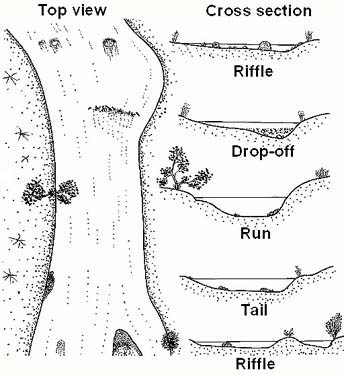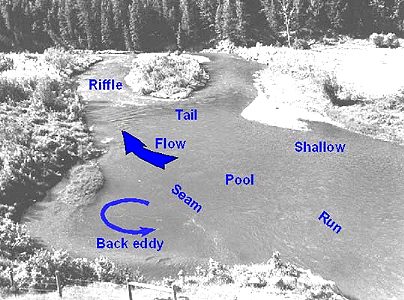Trout streams
By Clive Schaupmeyer
Adapted from "The Essential Guide to Fly-Fishing" by the author
Rivers, streams and creeks are as alluring as the trout they harbor
and nourish. Sure, we all love catching fish, but one of the pleasures
of fly-fishing in streams is the fascination we get from wading in these
spellbinding, flowing watery habitats.
Streams vary widely. Slow-flowing spring creeks meander through
pastureland and change little with time. Rivers and streams fed with melting
snow and rainwater babble peacefully through mountain gorges and get larger
as the head downstream. But these sometimes peaceful waters have another
face. Spring rains coupled with high temperatures that melt upland snows
can turn them into raging torrents. Raging rivers can be brutal to the
fish and it's a wonder they survive at all. But all of this mayhem has
been happening for millennia and will likely continue for a while longer
if we have the wisdom to protect our watersheds.
This flowing, scouring, wearing and grinding carves a river's
path through the geography. Because of this action the stream bed develops
a many-sided character that provides hiding, feeding and breeding places
for trout.
There are four general types of water that have been etched into
our ideal trout stream by the flow of water: riffles, runs, glides and
pools. There are all sorts of less-distinct hybrid water bearing characteristics
of two or three of these types. Within these four general types of water
are places where fish tend to congregate.

A riffle is a fast, choppy section of shallow water. The speed
is determined by the slope, and the roughness is caused by stream bed rocks.
This choppy, fast water is highly oxygenated and can hold incredible numbers
of insects. During significant insect activity, trout will often move into
riffles to feed on nymphs that are getting ready to emerge.
A run is a section of fairly fast and fairly deep water. Depending
on depth and stream bed rocks, the surface can be choppy or smooth. Runs
are often faster portions of wider sections of rivers bordered on one or
both sides by a wider, shallow shelf. Trout often hold at the bottom of
runs or in seams between the actual run and slower adjacent water. The
head, or upstream end of the run, is usually a dropoff just below a riffle.
Fish will hold at the head of a run waiting for dislodged nymphs to float
along or waiting for mayflies that emerged in the riffle. The end of a
run is called the tail. (The word run is sometimes used by fly anglers
around here to identify sections of streams and rivers–such as the Dog
Run or Deer Run. These locations include several types of water.)
A glide, or flat, is a section of slow, smooth water. Most are
a few feet deep, but some glides are quite shallow and are smooth because
of the slow water speed and smooth stream bed. Glides can be very difficult
to dry-fly fish and often require very long and light leaders. The smooth,
slow water allows the fish to get a clear and close look at a dry fly.
Wading quietly is critical because of the surface smoothness and lack of
natural water noise.
Pools are relatively slow, deep sections of a stream or river.
They often occur where a severe dropoff has carved a deep pocket. Trout
tend to hold in pools during hot weather and in winter. Pools are considered
to be favorite haunts of large trout. Because of their depth they can be
difficult to fish.
These water types are often connected in some predictable way,
yet the combinations are infinite. Water in a typical section of a river
might run through a riffle that drops off into a deeper run. The deeper
run may have shallower side sections. The run may become shallower and
evolve into a glide or flat. And as the gradient changes, it may narrow
again, forming the tail that speeds up and transforms into yet another
riffle that becomes the head of the next run. And on and on . . .

Glossary
Spring creek: A stream fed primarily from underground springs with
alkaline water. The water temperature in a spring creek tends to be more
stable than in a freestone stream. They often stay open throughout the
winter. Also called limestone or chalk streams.
Freestone stream: A stream fed primarily with surface runoff from rain
and snowmelt.
Next week: Reading trout streams. ~ Clive Schaupmeyer
Our Man In Canada Archives
|

 January 25th, 1999
January 25th, 1999




 January 25th, 1999
January 25th, 1999



